
Glass is a transparent or translucent solid material that is widely used in various applications, including windows, lenses, mirrors, and optical fibers. The optical properties of glass play an important role in these applications, and they are determined by various factors such as composition, structure, and processing.
Here are some of the optical properties of glass:
- Refractive index: Glass has a refractive index that determines how much it bends light as it passes through it. The refractive index of glass varies depending on the composition and can range from 1.45 to 1.90.
- Transparency: Glass is transparent to visible light, which means it allows light to pass through it without scattering or absorbing it. The degree of transparency depends on the composition, thickness, and surface quality of the glass.
- Absorption: Glass absorbs some wavelengths of light, especially in the ultraviolet and infrared regions. This property can be useful in applications where specific wavelengths need to be filtered or blocked.
- Reflection: Glass can reflect light, which makes it useful for making mirrors or other reflective surfaces. The amount of reflection depends on the surface quality and angle of incidence.
- Dispersion: Glass can disperse white light into its constituent colors, creating a rainbow-like effect. This property is often exploited in optical applications such as prisms and lenses.
Overall, the optical properties of glass make it a versatile material for various applications, particularly in optics and photonics.
